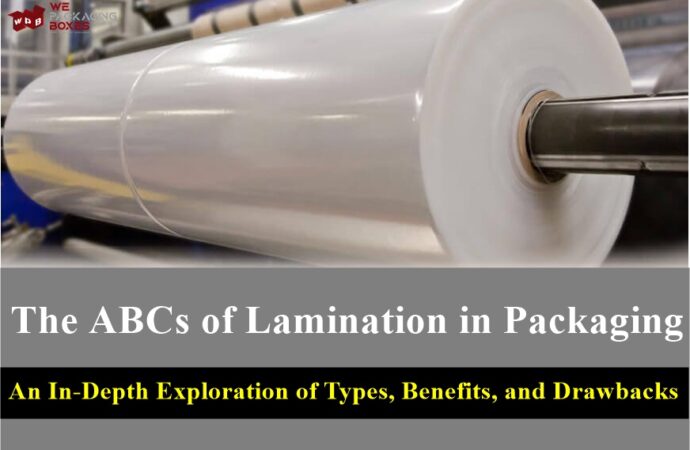In the world of packaging, the finishing touch often comes in the form of lamination—a process that involves applying a thin layer of protective material onto surfaces to enhance durability, appearance, and overall performance. This article delves into the various types of lamination used in packaging, unraveling the pros and cons associated with each. Whether
In the world of packaging, the finishing touch often comes in the form of lamination—a process that involves applying a thin layer of protective material onto surfaces to enhance durability, appearance, and overall performance. This article delves into the various types of lamination used in packaging, unraveling the pros and cons associated with each. Whether you’re a bundling proficient or an inquisitive customer, understanding the complexities of overlay can give significant bits of knowledge into decisions in the bundling business.
I. Types of Lamination in Packaging:
Polyethylene (PE) Lamination:
Polyethylene cover includes applying a layer of polyethylene onto paper or cardboard surfaces. This kind of overlay is broadly utilized in adaptable bundling, guaranteeing opposition against dampness and giving an obstruction against outside components. PE lamination is commonly employed in the production of food packaging, ensuring the freshness and integrity of the contents.
Pros:
Excellent moisture resistance.
Provides a protective barrier.
Enhances the overall strength of the packaging material.
Cons:
Limited recyclability due to the combination of materials.
Higher environmental impact compared to some alternatives.
Polypropylene (PP) Lamination:
Polypropylene overlay includes applying a layer of polypropylene onto different surfaces. Known for its flexibility, PP overlay is regularly utilized in a scope of bundling applications, from food bundling to marks and limited time materials. This type of lamination offers a balance between durability and visual appeal.
Pros:
Versatile and suitable for various applications.
High clarity for enhanced product visibility.
Resistant to chemicals and moisture.
Cons:
May not be easily recyclable in certain regions.
Limited barrier properties compared to other laminates.
PET Lamination:
Polyethylene terephthalate (PET) lamination involves applying a layer of PET onto surfaces. Recognized for its excellent clarity and strength, PET lamination is commonly used for clear packaging, labels, and product branding. It provides a glossy and protective layer, enhancing the visual appeal of the packaging.
Pros:
High clarity for showcasing product visibility.
Resistant to impact and scratches.
Fully recyclable in many regions.
Cons:
May not provide the same level of barrier protection as other laminates.
Production of PET involves the use of fossil fuels.
Biodegradable Lamination:
As the demand for eco-friendly packaging grows, biodegradable laminates have emerged as a sustainable alternative. These covers frequently use materials like PLA (polylactic corrosive) got from inexhaustible assets. Biodegradable overlay expects to lessen the ecological effect of conventional covers.
Pros:
Environmentally friendly and reduces reliance on fossil fuels.
Biodegrades naturally, minimizing long-term environmental impact.
Supports the shift towards sustainable packaging.
Cons:
Limited availability and higher cost compared to traditional laminates.
Biodegradation may require specific conditions to occur effectively.
II. Benefits of Lamination in Packaging:
Enhanced Durability:
Lamination significantly improves the durability of packaging materials. It provides a protective layer that shields against scratches, tears, and other forms of damage during transportation, handling, and storage. This is particularly crucial for products that undergo extensive handling in the retail and supply chain.
Moisture and Barrier Protection:
Overlays like PE and PET proposition astounding dampness and obstruction assurance. These covers make a safeguard against outer components, forestalling dampness entrance and safeguarding the honesty of the bundled merchandise. This is especially critical for food packaging, pharmaceuticals, and other products sensitive to environmental factors.
Improved Visual Appeal:
Lamination enhances the visual appeal of packaging materials. Glossy finishes, high clarity, and vibrant colors contribute to an attractive presentation that captures consumer attention. For brands planning to stand apart on packed retail retires, the visual feel accomplished through overlay assume a critical part in shopper discernment.
Brand Differentiation and Communication:
Customized lamination allows brands to convey their identity effectively. Logos, graphics, and product information can be seamlessly integrated into the packaging, serving as a powerful tool for brand communication. Lamination not only protects but also elevates the overall packaging design, fostering brand differentiation in the market.
Ease of Cleaning and Maintenance:
Covered surfaces are frequently more straightforward to clean and keep up with contrasted with unlamented materials. This is especially profitable for bundling utilized in conditions where tidiness is fundamental, like in the food business. The defensive layer of cover improves on the cleaning system, guaranteeing that the bundling keeps up with its visual allure.
III. Drawbacks and Considerations:
Environmental Impact:
A significant drawback associated with traditional laminates is their environmental impact. Materials such as PE, PP, and PET are derived from fossil fuels and may pose challenges in terms of recyclability. Biodegradable laminates offer a more sustainable option, but widespread adoption and infrastructure for their proper disposal are still evolving.
Recycling Challenges:
The blend of various materials in covers can present difficulties to reusing processes. Isolating the overlaid layers for the purpose of reusing may require specific offices, and the absence of a normalized approach worldwide confounds the reusing of covered bundling.
Cost Considerations:
The cost of lamination materials and processes may be higher compared to non-laminated options. Brands need to weigh the benefits of enhanced durability, visual appeal, and barrier protection against the associated costs. However, as demand for sustainable packaging grows, the cost dynamics of eco-friendly laminates may change.
Limited Compatibility with Certain Applications:
While overlays offer various advantages, they may not be appropriate for each bundling application. Certain items or ventures might require particular bundling arrangements that don’t include cover. Furthermore, the decision of cover ought to line up with the particular requirements of the item and its planned use.
IV. The Future of Lamination in Packaging:
As manageability turns into a main concern for customers and organizations the same, the fate of cover in bundling is probably going to be molded by headways in eco-accommodating materials and cycles. Developments like biodegradable overlays, compostable movies, and reusing well-disposed choices are getting some momentum, offering a more economical way ahead.
Collaboration between stakeholders in the packaging industry, including manufacturers, brands, and consumers, will play a pivotal role in driving positive change. A collective commitment to sustainable practices, coupled with technological advancements, will pave the way for a future where lamination enhances packaging durability and aesthetics without compromising environmental responsibility.
Concluding Remarks:
In the complex world of packaging, lamination stands as a multifaceted tool, offering a range of benefits and considerations. From enhancing durability and visual appeal to providing moisture and barrier protection, lamination plays a crucial role in packaging design and functionality. The decision of cover type includes gauging the advantages and disadvantages, with a rising spotlight on supportability molding the future scene of bundling materials and cycles. As we explore this always advancing landscape, the harmony between advancement, feel, and ecological obligation will shape the following section in the narrative of bundling overlay.



















Leave a Comment
Your email address will not be published. Required fields are marked with *